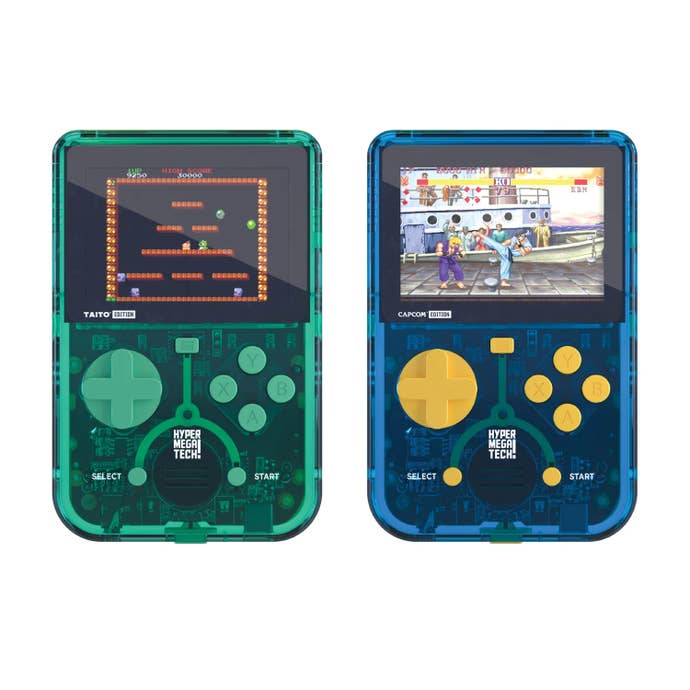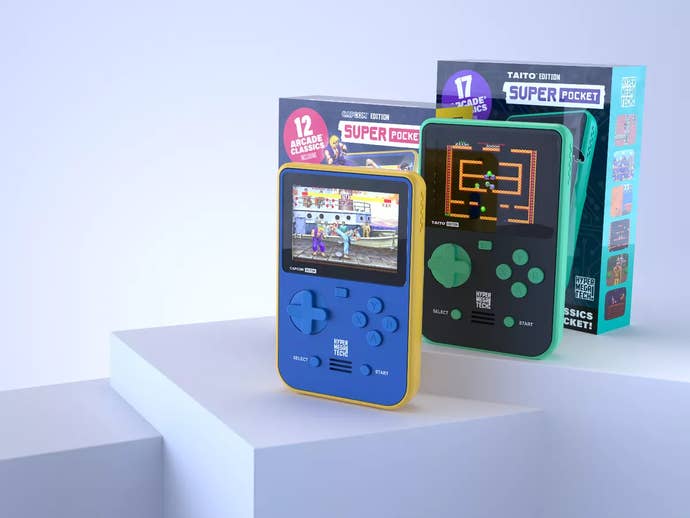The Super Pocket is a glorious retro handheld that doesn’t require a lottery win to own
Cheap, cheerful, and a good, solid bit of tech for the price – anyone craving some retro handheld goodness can do worse than the Super Pocket.
As a certified old man, at least in video game industry years (which aren’t that dissimilar to dog years), it should come as no surprise that I love a retro handheld. Everyone in their thirties does.
Everyone my age has fond memories of handheld gaming systems, be that Game Boys or vaguely crap Tiger Electronics LCD games, or whatever esle. To my younger self, the idea of carrying around a huge selection of my favorite games at once without the fear of losing a cartridge case packed with hundreds of pounds worth of software was a dream. Losing one cart was bad enough – rest in peace to my wayward copy of Super Mario Land 2: Six Golden Coins, lost on some shopping trip or another – carrying around everything you owned was too much to bear.
Fast forward a couple of decades and, obviously, it’s all rather trivial. The phone in my pocket has more processing power than the computers that helped to pilot the planes that I was terrified of leaving my Game Boy behind on when going on holiday. ‘Epic’ 16-meg cartridge games now take up less storage space than the photo you casually snap to humble-brag about your dinner in the group chat.
And yet… it doesn’t satisfy. I love a dedicated device. Over the years, I’ve tested a lot of them, too. From where I sit at my desk, I can see the Analogue Pocket and the AYN Odin - two different ends of the spectrum, offering highly accurate, original-cart using hardware and Android-powered software emulation respectively. But they do have one thing in common: they are expensive.
The Analogue Pocket runs $250. The Odin starts at $300, but spirals higher if you want a slightly better spec. For devices designed to run games that were made decades ago, it’s a bit rich.
This is what piqued my interest in the Super Pocket; a new device from UK company Blaze Entertainment, who are also behind the slightly higher-end Evercade devices. Meant to be cheap, cheerful, and eminently giftable, these are simpler devices – but they’ve an enormous amount of charm, too.

To draw on an analogy I’ve always enjoyed deploying when talking about retro gaming, think of it like the vinyl resurrection in music. If you want to get into vinyl, you can go to a high-end music store and buy either a genuine retro turntable or a modern, full-bodied, hyper-expensive turntable and bookshelf speakers. It’ll set you back probably a grand. Alternatively, you can pop to Costco or somewhere like that and pick up one of those cheap turntables that connects to your existing bluetooth speakers to play the album you just bought on 12” that was written and performed by people who weren’t even alive when vinyl was last mainstream.
The Super Pocket is the latter, by the way. It’s designed to be cheap – about £50 (or $60) – and they are simple, lightly durable devices. The sort of thing you can chuck in your carry-on luggage for a flight and not get too worried if it gets dinged up or even lost during your travels. And, well, I love my more expensive retro hardware, but there’s a bloody great charm to a device like this.
The Super Pocket is currently available in two configurations, with a curated selection of officially-licensed classic games. There’s an appropriately blue-and-yellow Capcom edition with the likes of Street Fighter 2, Mega Man, Ghouls n’ Ghosts, Final Fight, Strider, and so on. A black-and-green Taito edition ships with things like Space Invaders, Don Doko Don, Legend of Kage, Operation World, and Bobbles both Puzzle and Bubble.
These are mostly the arcade originals, but a few are the console versions. Because arcade games back then were punishingly hard in order to bleed players of their cash, the system also offers up an easy mode, which dials back the difficulty in each game to more sensible levels.

All of the built-in games can be played on their respective machine by default, but then there’s a removable cover that opens up a cartridge slot in the top. Into this you can slot any official Evercade cart - which balloons the library to over 500 classics. This does mean that you’ll need to carry a few extra carts with you if you want a greater library, however. With that said, the idea of carrying around readily available modern carts that top out at $20 each is a lot less scary than carrying precious retro originals that might be worth a fair bit, depending on the games.
As a device, it’s lovely for the money. It charges via USB-C, and its battery will deliver around 4 and a half hours of play, based on some rudimentary testing. Much of that battery is sapped by the rather lovely, crisp, 2.8-inch IPS screen. There’s a speaker, a headphone jack, and a SNES-style button layout - Start, Select, D-Pad, four face buttons, and ‘shoulder’ buttons, here placed on the rear. The only major difference is that there’s two sets of those shoulder buttons.
The D-Pad, always a tough test for these machines, sits in a pleasing position at the crossroads between firm and squishy, and is both comfortable to use and responsive enough to whip out a Shoryuken even within the tighter timing confines of arcade Street Fighter 2.
The rear buttons are the weak point. They’re perfectly positioned - if there were only two of them. When I hold the machine, my index fingers sit splayed across them - but it’s difficult to just hit L1 or L2, and not both at once - and the same on the right, of course. With that said, these are also the least frequently used buttons in this simpler arcade classics, so they are the buttons that matter least. It’s frustrating for things like the different attack strengths in Street Fighter, however, where the buttons are required. Then again, you’re not exactly going to be entering EVO on this thing. Perspective and context matters.

It’s all tied together by a tidy little UI for switching games, save states, and display options if you prefer to have fake scan lines and the like. I can’t stress enough, also, that the machine is surprisingly sturdy-feeling for a cheaper device - it doesn’t have that ‘hollow’ feel that often fills me with dread when I pick up a device in this price bracket. It’s dinky, and that impacts the controls, but it doesn’t feel nearly as cheap as it is.
The price is the point, really. It’s a clever little play on Blaze’s part, as it’s a cheap-as-chips entry point into their Evercade ecosystem. It’ll probably sell a few more Evercade machines and a lot more Evercade carts off the back of this. But even without that, these are lovely little stand-alone devices that could easily keep you occupied through a long flight or train journey.
I keep coming back to the price. I love my Analogue Pocket, and this isn’t replacing it - but for the price of the Pocket, you could pick up four of these, with change to spare. That’s what I call a giftable price; and every time I see one of those more expensive retro handhelds on a gift guide this holiday season, I think I’ll pause and think, “but there is a more realistic option”. That option is the Super Pocket.

